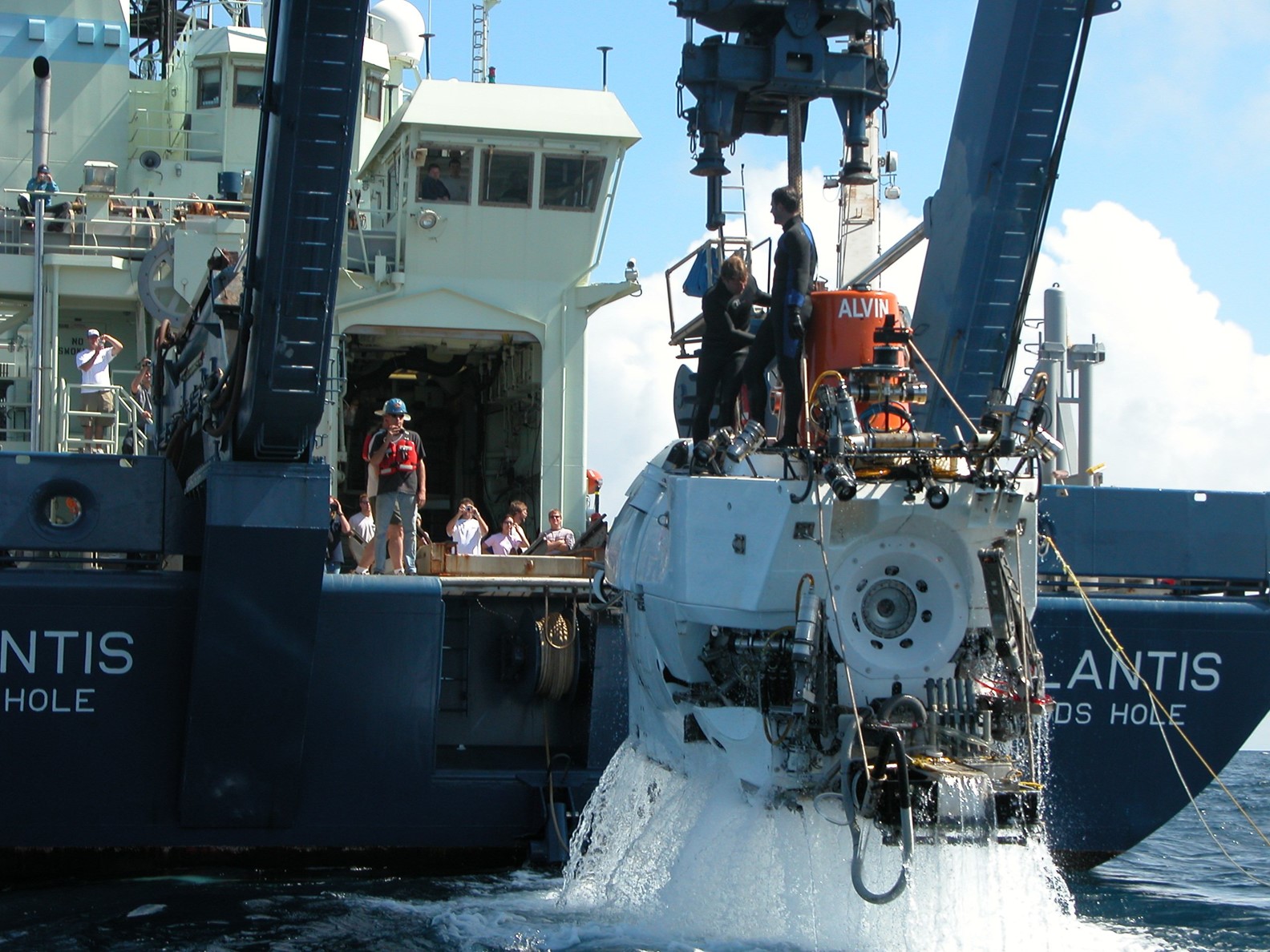
Credit: NOAA, public domain, via Wikimedia Commons
The world’s most successful research submarine, Alvin, has completed over 5,000 dives in its 60-year career.
Its first mission, in 1966, was to search for—and find—a hydrogen bomb that had fallen into the deep ocean.
Two years later, cables snapped while Alvin was being lifted aboard its tender ship, and it sunk to the bottom of the Atlantic … where the sub itself had to be retrieved.
It has been rebuilt several times since—each time making it more robust for deeper diving.
In the ‘70s and ‘80s, Alvin was the first to explore hydrothermal vents. Scientists expected them to be devoid of life, but were shocked to discover communities of shrimp, mollusks and giant tube worms, supported by symbiotic bacteria.
In 1986, Alvin visited the Titanic. In 2014, it searched for seafloor damage beneath the Deepwater Horizon accident. In fact, half of all deep-sea research missions have been aboard Alvin.
Every few years, the sub is completely disassembled so its parts can be inspected for cracks and wear. Several subs were built along with Alvin, and several more since, but Alvin has outlasted them all.
It’s now the Navy’s only sub that can transport researchers deeper than 20,000 feet. It will spend its 60th birthday doing what it does best, exploring the bottom of the Gulf of Alaska. I’m sure the scientists aboard will make time to celebrate this timeless little sub.
Background
Synopsis: The world-famous DSV Alvin was commissioned 60 years ago, on June 5, 1964. Today, it is the United States Navy’s only deep-submergence vehicle that can safely carry researchers to the seafloor, as deep as 21,300 ft (6,500 m). Upgrades were completed in 1973, 2014 and 2022 to keep it at the forefront of ocean exploration. The list of Alvin discoveries gets longer every year, from chemosynthetic hydrothermal “smokers” that changed our understanding of the origins of life to exploration of the sunken RMS Titanic. Scientists continue to keep the little sub busy with a variety of cutting-edge deep-sea projects.
- The DSV Alvin is operated by the Woods Hole Oceanographic Institute (WHOI).
- Its missions are supported by National Science Foundation (NSF), National Oceanic and Atmospheric Administration (NOAA) and Office of Naval Research (ONR) funding.
- The sub holds 3 people and has carried more than 3,000 different passengers in more than 5,100 dives.
- Around half of the manned research dives ever carried out in Earth’s oceans have been on the Alvin.
- There are only seven other manned submarines with similar capabilities that are currently active. Two of these have completed dives to the Challenger Deep. (ED-204 The Deepest Dive).
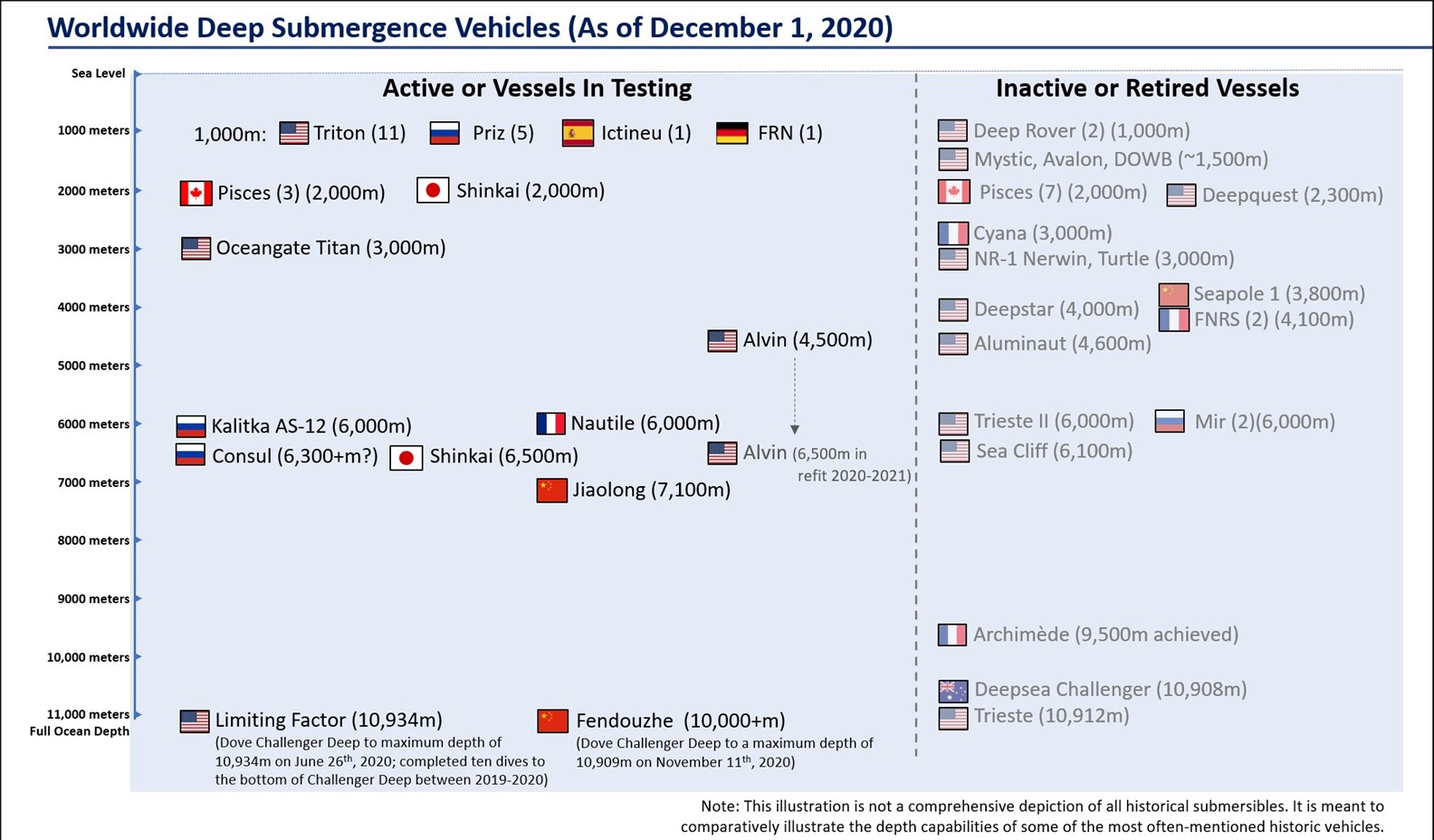
A graphic representation of all major manned deep-diving submersibles along with their maximum rated depth achieved and whether or not they were in active service in late 2020.
Credit: Vlvescovo, CC BY-SA 4.0, via Wikimedia Commons - In addition to science, Alvin has contributed to the engineering development of deep-submergence vehicles.
- In 1950, scientists did not have a way to observe the deep seafloor. Submarines either couldn’t go very deep, or they lacked windows.
- At a conference in 1956, oceanographers agreed with WHOI scientist Allyn Vine that a manned submersible would be preferable to remote viewing systems because people can sense and investigate, while instruments can only sense and record.
- The first deep-submergence vehicle was the windowed Trieste bathyscaphe (DSV-1), built in 1952 by Auguste Piccard and purchased by the U.S. ONR in 1957.
- It was unwieldy, but it informed the design of the more compact and maneuverable Alvin-class submarines.
- It was replaced by the Trieste II in 1963, which served until the mid-1980s.
- In the late 1950s General Mills inventor Harold “Bud” Froehlich had designed a small submersible vehicle called “Seapup” that became the model for Alvin-class submarines.
- This class of subs were named “Alvin” after the WHOI scientist Allyn Vine. The name stuck because of the popular cartoon chipmunk of the same name.
- After two years of construction, Alvin (DSV-2) was commissioned in June of 1964 at the WHOI dock and spent its first year doing test dives.
- Alvin earned its sub certification when it was piloted to its depth rating of 6,000 ft (1,800 m) on July 20, 1965, by its first pilot, ex-Navy submariner William Rainnie.
- Alvin has three retired siblings: DSV-3 Turtle was identical to Alvin, operating from 1968 to 1998, DSV-4 Sea Cliff operated from 1968 to 1998 and again briefly after 2002 and DSV-5 Nemo operated from 1970 to 1998.
- Alvin’s first big adventure came in 1966, when it joined the search for a hydrogen bomb that fell into the Mediterranean Sea off the coast of Spain.
- On January 17, 1966, during midair refueling of a B-52G bomber by a KC-135 tanker, the two U.S. Air Force planes collided, killing seven airmen and dropping four hydrogen bombs near the Mediterranean coast.
- The nonnuclear detonation of two of the bombs resulted in plutonium contamination of about 0.77 mi2 (2 km2) of land near a fishing village and a third was located intact, but the fourth ended up in the Mediterranean Sea.
- On March 15, under the command of Admiral William “Wild Bill” Guest, 18 U.S. Navy ships with 2,200 crew gathered to search for the remaining bomb. The ships included the USS Notable, which supported both the DSV Alvin and the larger Reynolds Metals Company Aluminaut submersibles.
- On April 2, Alvin found the bomb at a depth of 2,890 ft (869 m). It was recovered by the unmanned torpedo-recovery vehicle CURV-I on April 7, 1966, and loaded onto the USS Petrel.
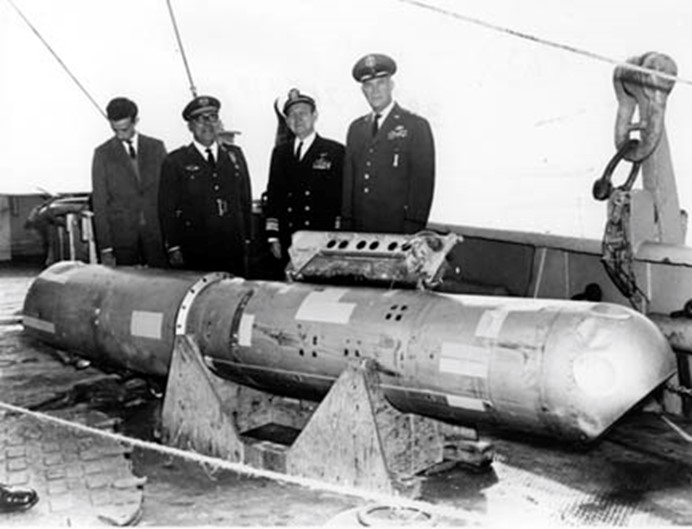
More than two months after it fell into the ocean following the January 1966 midair collision between a nuclear-armed B-52G bomber and a KC-135 refueling tanker over Palomares, Spain, this B28FI hydrogen bomb was located by the DSV Alvin and recovered by a remotely operated vehicle from 2,850 feet (869 meters) of water then lifted aboard the USS Petrel (note the missing tail fins and badly dented "false nose"). The B28 series of bombs had a maximum yield of 1.45 megatons, approximately 90 times more powerful than the nuclear weapon that destroyed 90% of Hiroshima, Japan. This photograph was among the first ever published of a U.S. hydrogen bomb.
Credit: U.S. Navy, courtesy of the Natural Resources Defense Council, public domain, via Wikimedia Commons
- Alvin’s worst accident happened in 1968, and it was a good thing that an Aluminaut was around.
- After cables on its tender ship Lulu snapped, Alvin dropped 5,200 ft (1,585 m) to the Atlantic seafloor south of Nantucket Island on October 16, 1968.
- Alvin waited with its hatch wide open on the seafloor for nearly a year while researchers decided whether they could retrieve it. Its larger aluminum “buddy,” Aluminaut, was able to retrieve it in September 1969.
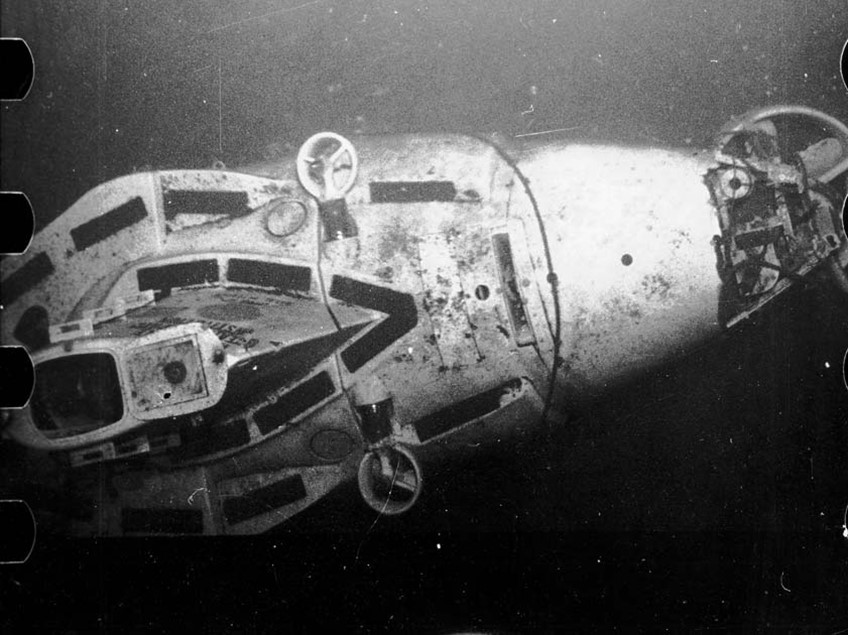
In 1968, while Alvin was being brought aboard its support ship, Lulu, a cable broke. With the hatch open, the submersible quickly filled with approximately 8,000 pounds (3,630 kilograms) of water and sank to a depth of 5,200 feet (1,585 meters) 88 miles (142 kilometers) off the coast of Nantucket, Massachusetts. This photo of Alvin was taken from DSV Aluminaut during the 1969 rescue mission.
Credit: Office of Naval Research, public domain, via Wikimedia Commons
- Alvin was rebuilt, increasing its depth capability to 14,800 ft (4,500 m), thus enabling dives to the Mid-Atlantic Ridge in 1973 (ED-015 The Longest Mountain Range).
- The biggest shock to scientists in the submersible was the ruggedness of the seafloor, especially as they neared the rift. They had imagined it would be much smoother (ED-286 First Map of the Ocean Floor).
- In 1977, Alvin crossed to the Pacific Ocean through the Panama Canal to begin one of its most famous missions: To transport scientists to the Galápagos Rift to study the interaction of seawater with spreading center volcanism.
- This Alvin mission enabled discoveries that forever revolutionized the way we think about origins and extremes of life, both on Earth and beyond.
- Scientists suspected that heat from Earth’s mantle was escaping into seawater at spreading center rift zones and hoped to prove that seawater was being heated as it was percolating through volcanics and leaching chemicals into the ocean at hydrothermal vents.
- They expected the ocean would be mostly barren of life at these depths, because there was no sunlight for photosynthesis.
- They found the vents and confirmed they were spewing out mineral laden hot water but were not prepared for what they found near the vents—huge, thriving communities of clams, mussels and giant tube worms.
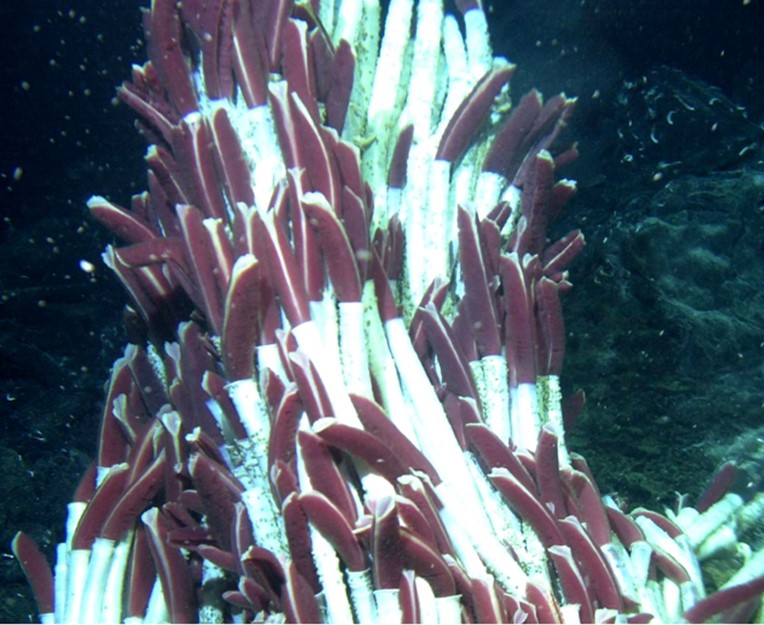
Tube worm habitat at 9.5°N on the East Pacific Rise in 2010.
Credit: Sabine Gollner et al., CC BY 2.5, via Wikimedia Commons - In 1979, further Alvin research dives confirmed that microbes, operating chemosynthetically, form the base of the food chain around the vents and that most of the larger deep-sea animals had no mouths or digestive systems, relying on internal symbiotic bacteria to provide an energy source (food) in return for safe haven inside the animals.
- In that same year, Alvin dove on the East Pacific Rise at 21°N, this time finding the “black smokers” that belched acidic black plumes of mineral-rich water at more than 678°F (359°C).
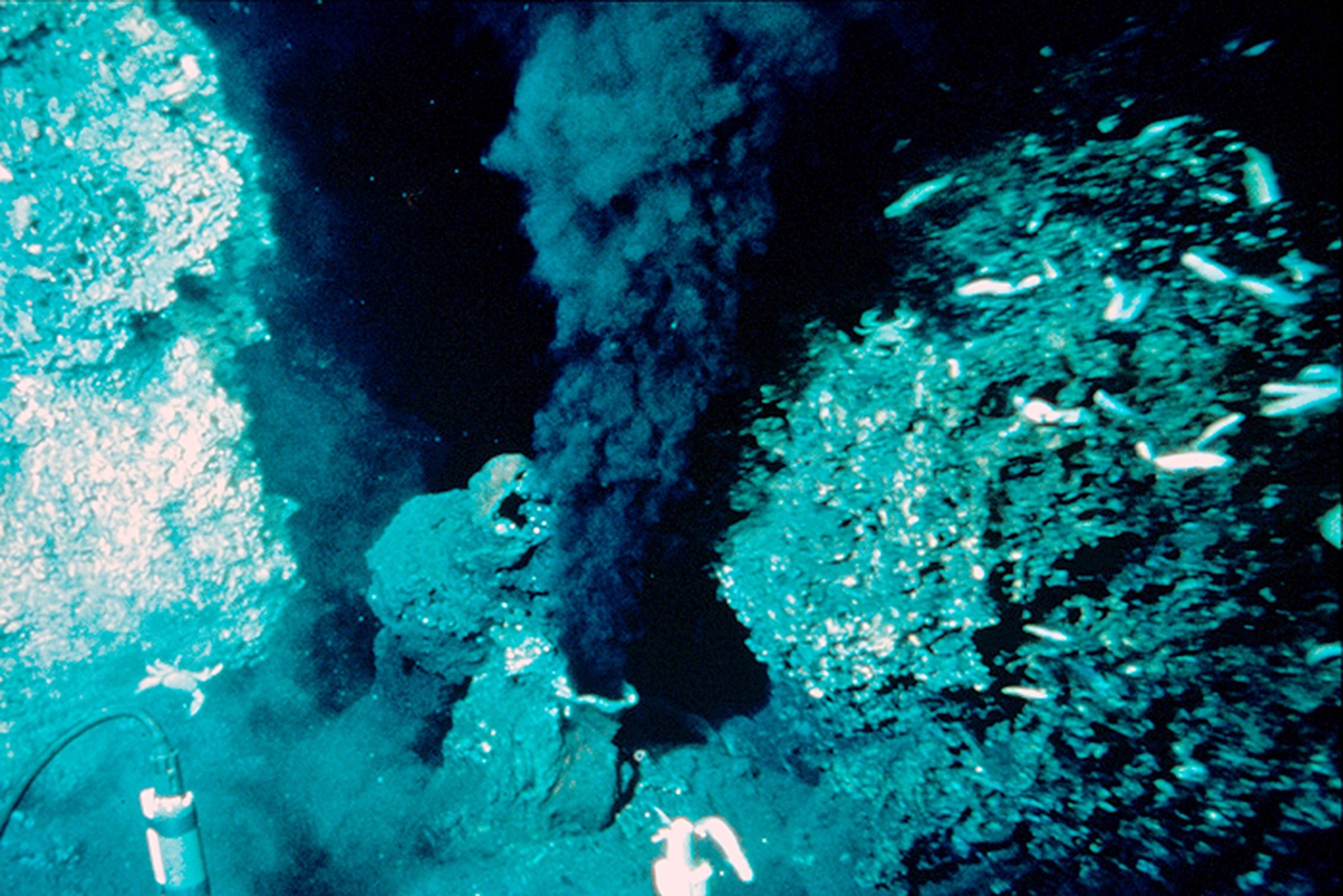
East Pacific Rise at 21°N latitude, showing the base of a “black smoker" chimney in the Pacific Ocean.
Credit: W.R. Normark, Dudley Foster, public domain, via Wikimedia Commons - In 1985, Alvin also found hydrothermal vents on the Mid-Atlantic Ridge swarming with shrimp that lived with symbiotic bacteria, and in 2000, it found 60-ft-tall (20 m) white tower formations along the ridge that were named “the Lost City.”
- Over time, Alvin scientists also discovered and explored cold seeps of hydrogen sulfides and methane around the Florida Escarpment, in the Gulf of Mexico, in the Gulf of California, and in the Guaymas Basin of Mexico.
- In another famous voyage, Alvin visited the 1912 wreck of the RMS Titanic in 12,500 ft (3,800 m) of water in 1986, piloted by Dr. Robert Ballard.
- The Titanic sank on her maiden voyage on April 15, 1912, after striking an iceberg. More than 1,500 people died.
- Alvin had been fitted with electric thrusters and brought a remotely operated sidekick, the Jason Junior, along for the adventure. It also had a new support ship, the RV Atlantis II.
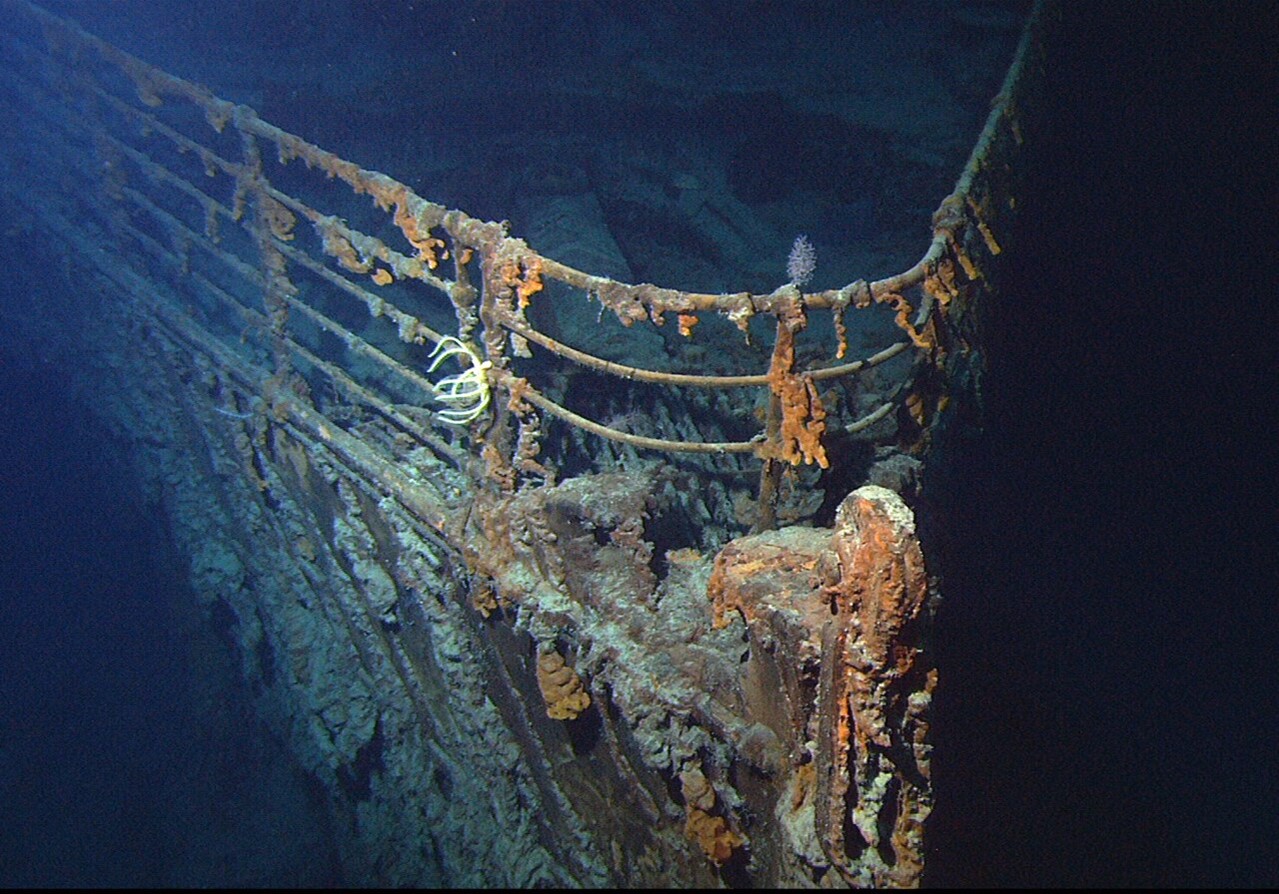
View of the bow of the RMS Titanic, photographed in June 2004 by the ROV Hercules during a later expedition returning to the shipwreck of the Titanic. The Alvin and the prototype Jason Junior remotely operated vehicle first visited the wreck in 1986.
Credit: NOAA/Institute for Exploration/University of Rhode Island (NOAA/IFE/URI), public domain, via Wikimedia Commons
- Alvin is booked for science expeditions years in advance.
- In March and April of 2014, Alvin revisited deep coral communities from previous studies to look for damage near the site of the Deepwater Horizon oil spill.
- In 2022, Alvin was upgraded with a refit to enable dives to 21,325 ft (6,500 m).
- On Alvin’s 60th birthday, the sub will be busy researching microbial communities of the deep-ocean methanosphere in the Gulf of Alaska with Dr. Lisa Levin of the University of California San Diego’s Scripps Institution of Oceanography. Maybe they will have time to celebrate!
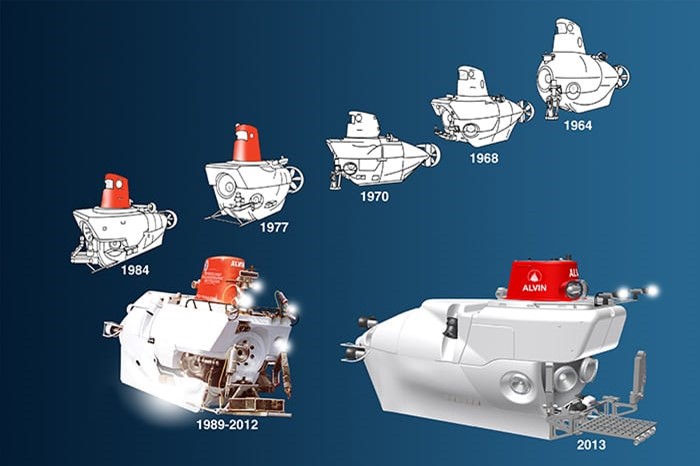
In 60 years of operation, the deep-submergence vehicle Alvin has evolved and changed its look several times. In fact, the sub has been completely disassembled every three to five years so engineers can inspect every last bolt, filter, pump, valve, circuit, tube, wire, light and battery—all of which have been replaced at least once in the sub's lifetime.
Credit: E. Paul Oberlander, Woods Hole Oceanographic Institution

